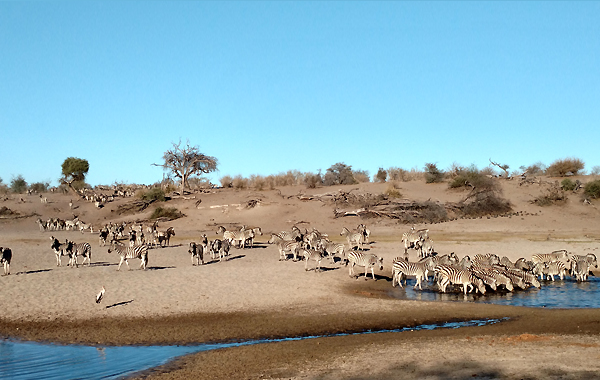 We spent seven days game viewing in one of the most brutal droughts Botswana has ever seen. First-timers thought it was wonderful, because the cats are having a heyday. There was blood everywhere.
We spent seven days game viewing in one of the most brutal droughts Botswana has ever seen. First-timers thought it was wonderful, because the cats are having a heyday. There was blood everywhere.
There are few pools of water left in Chobe or the Makgadikgadi that aren’t artificial. Elephant dug a few tiny pools in parched river bottoms, but it was only the drainage from camps and national park boreholes (wells) that have kept total disaster at bay.
We watched perhaps a thousand zebra in the Makgadikgadi as they wandered to and from the dry river for the bits of grass that grow near the boreholes. They looked healthy enough and there were a few young. That’s not unnatural for Botswana zebra which endure a much harsher climate even in normal times.
We also saw healthy families of kudu, smatterings of not-so-healthy looking southern wildebeest and tsessebe, and lots of steenbok. We also saw very sick groups of impala in the Okavango and Chobe. All these creatures have been kept alive by bits of grass in diminishing places around the artificial boreholes.
Big game in southern African national parks has been dependent on artificial boreholes for over a century, so they know how to do it. This drought, however, is way more serious than in the past. It has seriously altered normal animal behaviors. My last blog talked about the altered behavior of elephant in the Makgadikgai where males are breaking down inhibitions of being together to better raid farms at night.
As Chobe grows drier and drier the boreholes are increasingly important for the elephant. We counted 35 elephant at one small borehole on our morning game drive but that wasn’t so terribly unusual.
What was unusual was that all 35 elephant were male. Only at the lodge’s borehole at night did we see families of young and females, and then only briefly. According to our guides both experiences affirmed the seriousness of the current drought.
You can take this to the logical conclusion should the drought continue. There’s nothing sustainable about a population of only males.
Similarly we saw some heart-breaking lion behavior that’s also been distorted by the drought.
Cats thrive in a drought: Their prey is weakened; prey take greater risks to drink at boreholes where lions stage their ambush; and the camouflage cover provided by natural foliage is greatly reduced.
But because the areas of functioning wildlife in Botswana are being reduced to the areas around the artificial boreholes, the territory for natural predator expansion is drastically reduced.
Normally young male lion – like young males of many animal groups including elephant – are kicked out of the family unit before they get as big as their mother, a natural strategy to avoid inbreeding.
Young male lion are normally kicked out when they’re about 14 months old. They disperse to new areas and if they’re successful teaching themselves to hunt, they establish new territories and prides expanding the overall lion population.
But there’s no place to disperse to, now. Any square meter of Botswana not supported by an artificial borehole or the great rivers at the northern border of the country is a dying field.
In Savute we first saw a magnificent pride of lion that was just finishing up 3-4 days of sleeping off a recent kill. There were three females with two sets of cubs, four and five months old, and a truly grand male with one of the finest manes I’ve seen.
But our guide explained the pride was even bigger than what we were seeing. He said that some of the younger males normally kicked out of the pride were still around, and what’s more, we’re being allowed to feed on the family’s kills!
Not without serious pain. Our guide took us about a half kilometer from the main pride to a single stunted-looking but full-grown male with a decent mane who was sleeping off his portion of the family’s kill.
He was 3 years and 8 months old, had been kicked out of the pride normally when he was 14 months old but then returned when the drought intensified.
His horrible scars were proof how desperate he was. He’d lost part of his tail, had major lacerations to his face and huge hunk scars on his flank. But he was surviving. Surviving by enduring the torture not only of the male but the females as well.
The real change in behavior, though, wasn’t with this desperate kid. Lions endure all sorts of injuries attempting their kills and fighting with one another. Rather, it was with the rest of the pride that normally would have by now – and could in an instant – kill him.
They haven’t. The pride didn’t caucus to conclude that the very survival of Savute lions depended on letting the kid live until the drought ended and he could expand the population.
Instinct showed them the way. But instinct also led the male elephants to exclude the females and young from the borehole. So in unnatural times instinct is not always the way to win. But with these lions it just may be.